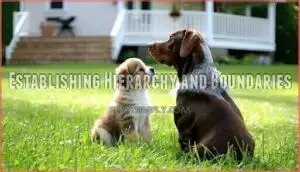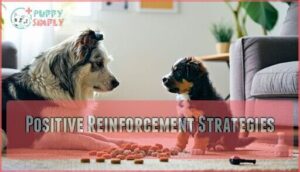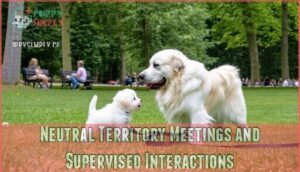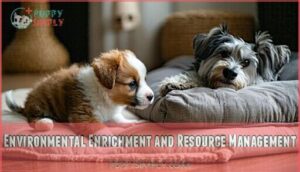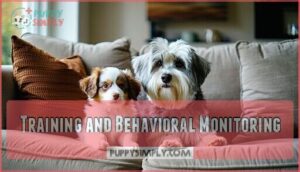This site is supported by our readers. We may earn a commission, at no cost to you, if you purchase through links.
 Introducing a puppy with an older dog requires careful planning and patience.
Introducing a puppy with an older dog requires careful planning and patience.
Your senior dog’s established routines and energy levels differ substantially from a bouncing ball of fur that sees everything as a potential chew toy.
Start with controlled introductions in neutral territory, then gradually increase supervised interactions at home.
You’ll need separate feeding areas, individual rest spaces, and plenty of positive reinforcement for both dogs.
The age gap can actually work in your favor—older dogs often become natural mentors when given proper time to adjust.
Managing this shift successfully involves understanding each dog’s unique personality and creating an environment where both feel secure and valued.
Table Of Contents
- Key Takeaways
- Getting New Puppy
- Older Dog Acceptance
- Managing Multi-Dog Household
- Health and Behavior Impact
- Successful Integration Strategies
- Long-Term Care Considerations
- Frequently Asked Questions (FAQs)
- Will an older dog be ok with a puppy?
- How long until an older dog accepts a puppy?
- Can a puppy play with older dogs?
- Are dogs happier with a second dog?
- How do you handle different dietary needs?
- When should you consult a veterinary behaviorist?
- What insurance considerations apply to multiple dogs?
- How do you manage different sleep schedules?
- Conclusion
Key Takeaways
- Start with neutral territory introductions – You’ll prevent territorial behavior by meeting in parks or quiet streets before bringing the puppy home, allowing both dogs to interact without your older dog feeling defensive.
- Create separate resources and spaces – You’ll need individual feeding stations, sleeping areas, and toys to eliminate competition and give each dog their own safe retreat space.
- Use positive reinforcement consistently – You’ll build acceptance by rewarding calm behavior around the puppy with high-value treats and praise within 3 seconds of good interactions.
- Monitor energy levels and adjust activities – You’ll succeed by matching exercise routines to each dog’s needs, providing shorter play sessions for seniors while managing your puppy’s burst of energy through separate activities.
Getting New Puppy
You’ll need to evaluate your older dog’s temperament and social skills before bringing home a new puppy.
Every dog deserves a proper introduction—assess your senior pup’s personality before adding a furry tornado to the mix.
Choose a puppy breed that matches your senior dog’s energy level and size to create the best foundation for a harmonious household with a suitable size.
Assessing Senior Dog’s Compatibility
Before getting a puppy, you’ll need to evaluate your senior dog’s readiness for canine companionship.
Dog Temperament and Energy Levels substantially impact successful introductions, with 60% of older dogs showing decreased tolerance to high-energy puppies.
Consider these compatibility factors:
- Health Checks – Arthritis affects 20-30% of senior dogs, limiting play interactions
- Breed Considerations – Herding breeds typically show less puppy tolerance than others
- Owner Lifestyle – Your time for managing both dogs affects integration success
Understanding a dog’s compatibility test results is vital for a harmonious household.
Choosing Right Puppy Breed
Breed selection determines household harmony when choosing your puppy companion.
Smaller breeds like Cavalier King Charles Spaniels won’t overwhelm senior dogs, while their moderate energy levels match aging pets perfectly.
Consider grooming needs and trainability factors—low-maintenance breeds reduce stress for everyone.
Dog breed temperament matters most; calm dispositions create peaceful coexistence rather than chaos.
Ensuring Fairness for Both Dogs
You’ll create a balanced household where fair treatment and dog equality flourish through resource sharing strategies.
Provide balanced attention to prevent jealousy while establishing clear boundaries for harmonious coexistence.
Your puppy older dog introduction success depends on equal meal times, toy access, and affection distribution.
This multidog household approach guarantees both dogs feel valued, preventing competition and fostering positive dog relationships through consistent, equitable care, ensuring a household with harmonious coexistence.
Older Dog Acceptance
Your older dog’s acceptance of a new puppy depends on establishing clear hierarchy and consistent boundaries from day one.
Positive reinforcement strategies help both dogs understand their roles while building confidence in their shared living space, which is crucial for establishing a harmonious household with consistent boundaries.
Establishing Hierarchy and Boundaries
Most successful dog introduction strategies start with establishing clear boundaries between your puppy and older dog.
Pack dynamics naturally emerge when you set household rules consistently. Canine communication improves when both dogs understand their roles.
Your older dog puppy relationship thrives with structured dog hierarchy. Don’t buy into outdated dominance theory – focus on establishing boundaries through positive leadership instead, which helps in creating a clear pack dynamics.
Positive Reinforcement Strategies
Reward training transforms your older dog’s mindset about the new puppy.
Use high-value treats and praise techniques to reinforce calm behavior around your pup. Clicker methods provide precise timing for behavior shaping, while treat motivation encourages positive interactions during puppy socialization sessions.
- Immediate rewards – Give treats within 3 seconds of calm older dog training moments
- High-value treats – Use special rewards like freeze-dried liver for breakthrough moments
- Clicker timing – Mark exact moments when your dog shows acceptance toward the puppy
- Consistent praise – Combine verbal encouragement with physical affection for lasting positive reinforcement
Effective training utilizes positive reinforcement techniques to promote a harmonious environment.
Managing Multi-Dog Household
Once you’ve established initial acceptance between your dogs, the real work begins with managing daily interactions in your multi-dog household.
You’ll need strategic planning for feeding, sleeping, and playtime to prevent conflicts and create lasting harmony.
Separate Feeding and Resting Areas
Dedicated Feeding Stations and Rest Areas prevent competition between your puppy and older dog.
Food Separation eliminates mealtime stress, while Quiet Spaces give each dog their own Private Quarters for undisturbed rest.
Understanding dog aggression triggers is essential for maintaining harmony in a multi-dog household.
| Setup Area | Puppy Requirements | Senior Dog Needs |
|---|---|---|
| Feeding Stations | Elevated bowls, smaller portions | Ground-level access, regular schedule |
| Rest Area | Soft bedding, chew-proof materials | Orthopedic support, minimal disturbance |
| Quiet Spaces | Crate training area, puppy socialization toys | Established favorite spot, familiar scents |
| Private Quarters | Safe confinement space | Retreat from puppy energy |
| Resource Zones | Separate toy storage | Individual comfort items |
Preventing Resource Guarding and Conflicts
Beyond providing separate eating spaces, you’ll need proactive strategies to prevent resource guarding between your canine companions.
Watch for warning signs like stiff posturing or growling near valued items, which signal potential conflict escalation.
- Food Protection: Feed dogs in separate rooms to eliminate mealtime competition
- Resource Sharing: Provide identical toys and treats to reduce possessive behaviors
- Conflict Resolution: Teach "leave it" commands before tensions arise
- Space Management: Create designated retreat zones for each dog’s comfort
Supervised Play and Exercise
Monitor your pup’s playtime like a referee at a championship match.
Supervise dog interactions to prevent overwhelming your older dog’s energy levels, adjusting exercise routines based on each dog’s needs.
Watch for signs of exhaustion during puppy play sessions, ensuring both dogs develop healthy puppy social skills through structured supervised play.
Providing a safe dog play area is essential for their overall development and well-being.
This ensures that both dogs have a positive experience, and healthy puppy social skills are developed.
Health and Behavior Impact
Adding a puppy to your household creates significant behavioral and health changes for your older dog that you’ll need to understand and manage.
The energy dynamics between a high-spirited puppy and a calmer senior dog can either rejuvenate your older companion or create stress that affects both dogs’ well-being.
Socialization Benefits for Both Dogs
Your household benefits tremendously when both dogs develop stronger social skills through daily dog interactions.
Puppy confidence grows 40% faster when learning from older dog socialization, while senior dogs regain enthusiasm through pack dynamics.
These canine bonds reduce behavioral problems by 25% and improve communication skills by 30%.
Effective puppy training socialization creates lasting benefits for both companions.
Proper socialization techniques are essential for raising well-adjusted puppies.
Energy Level Considerations and Adjustments
Energy mismatches can spark household chaos, but you’ll find success through smart Playtime Management strategies.
Your older dog exercise routine needs gentle adjustments while accommodating your puppy energy bursts.
Consider these Activity Levels approaches:
- Schedule shorter, frequent play sessions instead of marathon romps
- Use Calming Techniques like puzzle toys during your puppy’s peak energy hours
- Match Exercise Needs by creating separate activity zones for different dog energy levels
Energy Level Considerations become manageable when you respect each dog’s natural rhythm and capabilities.
Reducing Stress and Anxiety in Dogs
Managing your dogs’ emotional well-being requires recognizing stress signals and implementing effective calming techniques.
Watch for anxiety triggers like panting, pacing, or destructive behavior when introducing your puppy to your older dog.
| Stress Signals | Calming Techniques |
|---|---|
| Excessive panting | Create separate safe spaces |
| Pacing or restlessness | Use calming pheromone diffusers |
| Destructive chewing | Provide environmental enrichment |
| Resource guarding | Implement positive reinforcement training |
| Withdrawal behavior | Maintain consistent daily routines |
Environmental modifications and relaxation methods help both dogs adjust to their new living situation, promoting calm behavior and successful canine behavior integration.
Successful Integration Strategies
You’ll need proven strategies to guarantee your puppy and older dog bond successfully without stress or conflict.
These evidence-based techniques focus on gradual introductions, proper resource management, and ongoing behavioral assessment to create lasting harmony.
Neutral Territory Meetings and Supervised Interactions
Smart introduction techniques start with neutral meetings away from your home turf.
Your older dog won’t feel like defending territory, and your puppy experiences less overwhelming stimuli during these vital first encounters.
- Choose neutral ground like a park or quiet street for initial introductions
- Try fence meetings where dogs can see and smell each other safely
- Use parallel walking with both dogs on leashes, maintaining distance
- Allow sniffing opportunities while keeping interactions brief and positive
- Ensure supervised interactions with immediate intervention if tension arises
Environmental Enrichment and Resource Management
Creating enriched environments prevents resource competition while supporting healthy development for both your puppy and older dog.
Toy Rotation maintains novelty, while Space Optimization guarantees each dog has designated areas. Strategic Resource Allocation reduces tension during meals and playtime.
Effective dog feeding stations, such as elevated dog feeding systems, can also contribute to a more harmonious environment.
| Resource Management Strategy | Implementation |
|---|---|
| Feeding Stations | Separate bowls in different rooms prevent resource guarding |
| Toy Rotation Schedule | Alternate toys weekly to maintain interest and reduce conflicts |
| Scent Work Areas | Designated sniffing zones provide mental stimulation for both dogs |
| Outdoor Access Points | Multiple entry/exit options prevent bottlenecking during excitement |
Training and Behavioral Monitoring
Consistent puppy obedience training and vigilant behavioral monitoring form the backbone of successful integration.
Watch for canine communication signals like tail positions and ear movements that indicate stress or comfort. Implement reward systems that recognize positive interactions between both dogs.
Document puppy behavior problems early and adjust dog training methods accordingly. Regular behavioral assessments help identify when dog behavior modification techniques are needed for lasting harmony.
Addressing dog separation anxiety issues through separation anxiety training is essential for a peaceful multi-dog household, ensuring a state of comfort and promoting overall well-being through effective training.
Long-Term Care Considerations
Successfully integrating a puppy with your older dog requires ongoing attention to their evolving relationship and individual needs.
You’ll need to monitor how their energy levels, personalities, and dynamics change over time while maintaining fairness between both dogs.
Adjusting to Changing Needs and Energy Levels
As your puppy grows from bouncing furball to settled adolescent, you’ll need to adjust your Energy Level Management strategies.
Your older dog’s Needs Assessment becomes essential during this transformation period.
Age Considerations shift as your puppy’s boundless energy gradually decreases while your senior dog may experience further decline.
Household Adaptation requires flexibility in your Canine Lifestyle approach, ensuring both dogs receive appropriate exercise and mental stimulation for their current life stages.
Managing Jealousy and Favoritism in Dogs
When jealousy strikes your multi-dog household, you’re dealing with complex canine rivalry that requires strategic intervention.
Dog emotions run deep, and favoritism signs become obvious when pack dynamics shift after introducing a puppy to your older dog.
Watch for these jealousy triggers that demand immediate attention:
- Resource guarding behaviors – blocking food bowls, toys, or your attention
- Attention-seeking escalation – excessive barking, pawing, or destructive actions
- Withdrawal symptoms – depression, decreased appetite, or social isolation
Address dog jealousy through equal treatment protocols and structured introduction strategies that prevent favoritism from taking root.
Creating Safe Spaces and Fair Expectations
Establishing clear territories and expectations prevents competition between your dogs.
You’ll need designated spots where each pet can retreat without interference from the other.
Fair treatment means equal attention, training opportunities, and resources for both animals.
| Space Design | Fair Treatment | Boundary Setting |
|---|---|---|
| Separate feeding stations | Equal training time | No-go zones for each dog |
| Individual sleeping areas | Balanced attention | Respect personal space |
| Puppy-proofed safe zones | Same rule enforcement | Clear territory markers |
| Senior dog quiet retreats | Identical reward systems | Supervised interaction areas |
| Shared play spaces | Fair resource distribution | Established household rules |
Creating safe spaces and implementing fair expectations builds canine comfort while maintaining household harmony through proper puppy training socialization and older dog socialization techniques.
Frequently Asked Questions (FAQs)
Will an older dog be ok with a puppy?
Imagine this: you’re standing at the crossroads of canine companionship, wondering if your gray-muzzled friend will welcome a bouncing bundle of fur.
Most older dogs adapt well to puppies with proper introductions, patience, and supervision, creating lasting bonds that benefit both dogs’ well-being.
How long until an older dog accepts a puppy?
Most older dogs accept puppies within 2-4 weeks with proper introductions. You’ll see gradual tolerance first, then curiosity, and finally acceptance as they establish their new relationship together.
Can a puppy play with older dogs?
Yes, puppies can play with older dogs when you supervise carefully.
You’ll want to watch for size differences and energy mismatches that could cause injuries or stress to your senior dog.
Are dogs happier with a second dog?
Most dogs thrive with companionship—studies show 75% have successful multi-dog relationships.
You’ll likely see increased playfulness, reduced anxiety, and better socialization.
However, some independent or poorly socialized dogs prefer solitude, so assess your dog’s temperament first.
How do you handle different dietary needs?
Feed dogs separately to prevent resource guarding and guarantee each gets appropriate nutrition.
Use different locations or feeding schedules.
Monitor portions carefully since senior dogs need fewer calories while puppies require frequent, nutrient-dense meals for growth.
When should you consult a veterinary behaviorist?
Ironically, seeking professional help often signals strength rather than failure when managing behavioral challenges.
You’ll need a veterinary behaviorist when persistent aggression, severe anxiety, or destructive behaviors don’t respond to basic training methods and threaten household harmony.
What insurance considerations apply to multiple dogs?
You’ll typically pay separate premiums for each dog, though some insurers offer multi-pet discounts.
Coverage limits apply per animal, so you’re basically doubling veterinary costs and potential claims when accidents happen.
How do you manage different sleep schedules?
Young pups need more sleep, seniors prefer established patterns.
You’ll create separate sleeping areas while respecting each dog’s natural rhythm.
Gradually adjust schedules through consistent bedtime routines that accommodate both ages comfortably, respecting the need for sleep.
Conclusion
Successfully introducing a puppy with an older dog resembles conducting an orchestra—each member needs time to find their rhythm together.
Through gradual introductions, separate resources, and consistent positive reinforcement, you’ll create harmony between different energy levels and personalities.
Your senior dog’s wisdom combined with your puppy’s enthusiasm can develop into a beautiful partnership.
Remember that patience during this adjustment period pays dividends in long-term household peace and canine companionship.

